Food Grade Alcohol Market Size and Trends
The food grade alcohol market is estimated to be valued at USD 2.51 Bn in 2025 and is expected to reach USD 3.39 Bn by 2032, growing at a compound annual growth rate (CAGR) of 4.4% from 2025 to 2032.
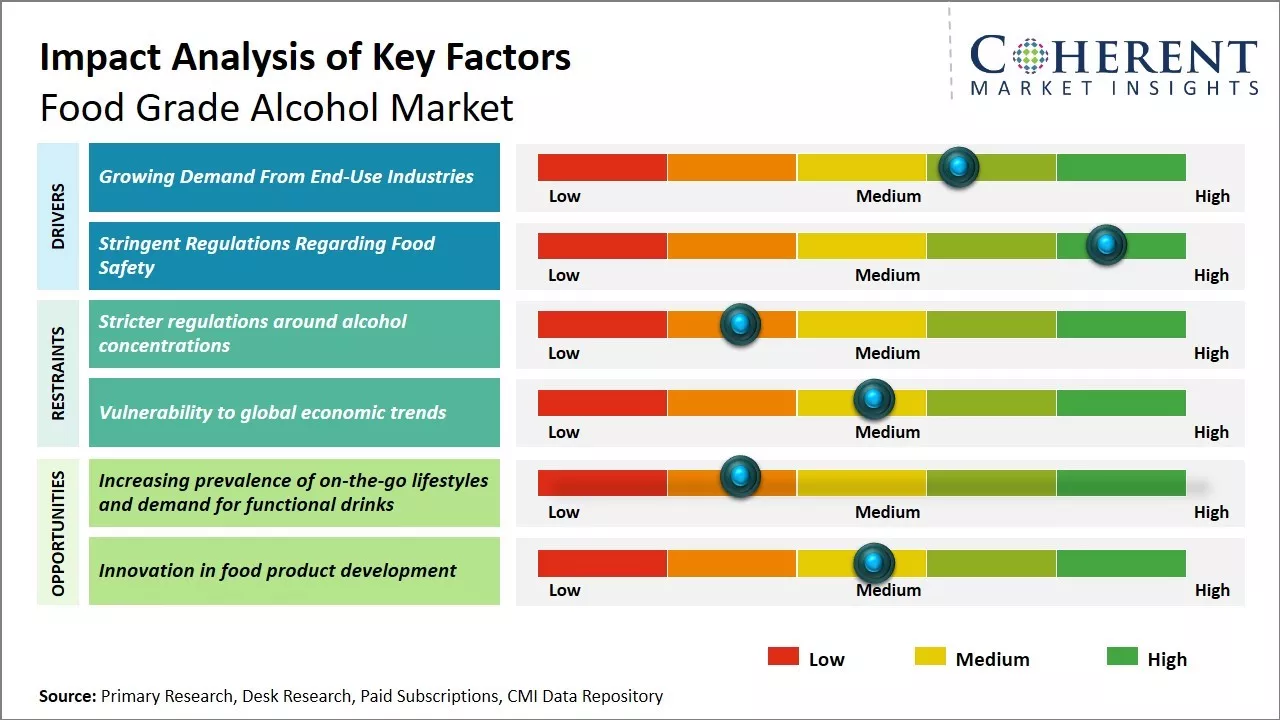
Discover market dynamics shaping the industry: Download Free Sample
The market is expected to witness positive growth over the forecast period. Rising demand for brewed beverages, such as beer, and increasing application of food grade alcohol in the food & beverages industry as a food additive and preservative are some of the major factors expected to drive the market growth. Furthermore, changing consumer preference towards low-calorie beverages owing to rising health consciousness is also projected to support the demand for food grade alcohol in the coming years. The wide application of food grade alcohol as a solvent for the extraction and purification of pharmaceutical and food products will further provide growth opportunities for players operating in this market.
Growing Demand from End-use Industries
The food grade alcohol market is driven by the growing demand from various end-use industries such as food & beverages, pharmaceuticals, personal care products, etc. Alcohol is widely used in the food and beverage industry due to its various applications such as it acts as a flavoring agent, preservative, solvent for the extraction and distillation of natural food ingredients. It is also used during the production of wine, beer, and spirits. The booming food processing industry globally has significantly contributed to the growth of this market. The demand from the pharmaceutical industry is also driving the market as alcohol finds applications in medications, hand sanitizers, and disinfectants. The recent COVID-19 pandemic has immensely boosted the production and sales of hand sanitizers which use alcohol as the main ingredient. This has positively impacted the food grade alcohol market. The personal care industry also utilizes alcohol in products like fragrances, cosmetics and skin care items. Its penetrating and emollient properties makes it suitable for use in beauty products. Rising health consciousness among people has increased the demand for herbal extracts in dietary supplements and Ayurvedic medicines which uses alcohol as solvent for the extraction of active medicinal compounds from plants. Changing lifestyles and busy schedules have led to the growing preference for packaged and ready-to-eat food items which contain alcohol as preservative. Thus, the expansion of the food processing and personal care industries along with the increased consumption of packaged foods is expected to drive the demand for food grade alcohol in the coming years.
Market Concentration and Competitive Landscape
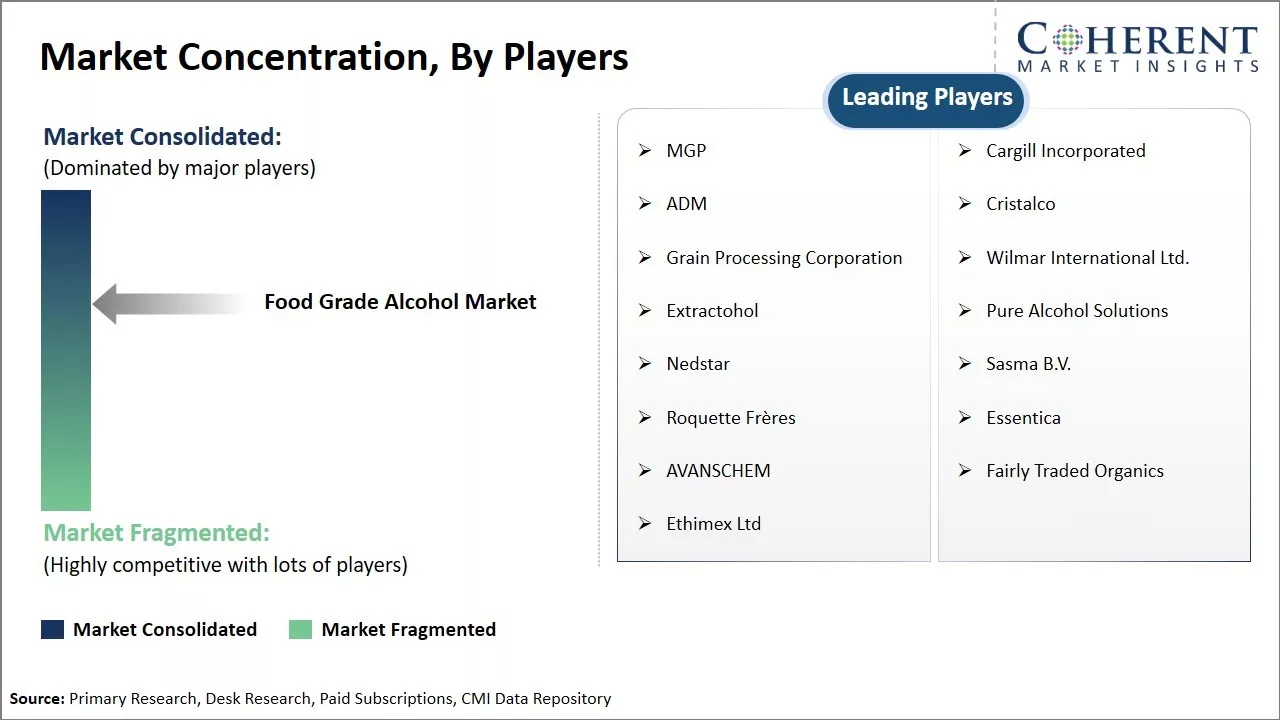
Get actionable strategies to beat competition: Download Free Sample
Stringent Regulations Regarding Food SafetyStringent regulations regarding food safety is one of the primary factors driving the growth of the food grade alcohol market. Governments across the world are implementing stricter guidelines to ensure the quality and safety of food products. Alcohol that does not meet the prescribed standards for food consumption cannot be used in the food industry. This has compelled food companies to rely solely on food grade alcohol that adheres to the regulatory norms. The food grade alcohol manufacturing industry has responded proactively to these regulations. Producers are investing heavily in R&D to come up with innovative purity testing technologies and upgrading production facilities. Advanced distillation and filtration methods allow manufacturers to remove impurities and contaminants from alcohol. They can certify that their products meet all criteria specified by regulatory bodies. This gives confidence to food businesses that opt for these alcohols. It has also increased transparency in a supply chain. The trend of stringent norms is likely to continue in the coming years. For instance, according to a study by the WHO, over 200,000 people require hospitalization every year globally due to contaminated food. Governments are under pressure to strengthen laws to curb foodborne illnesses. The food industry needs to comply with evolving standards. This dependable demand for certified pure alcohol from the food industry will spur growth opportunities for food grade alcohol producers.
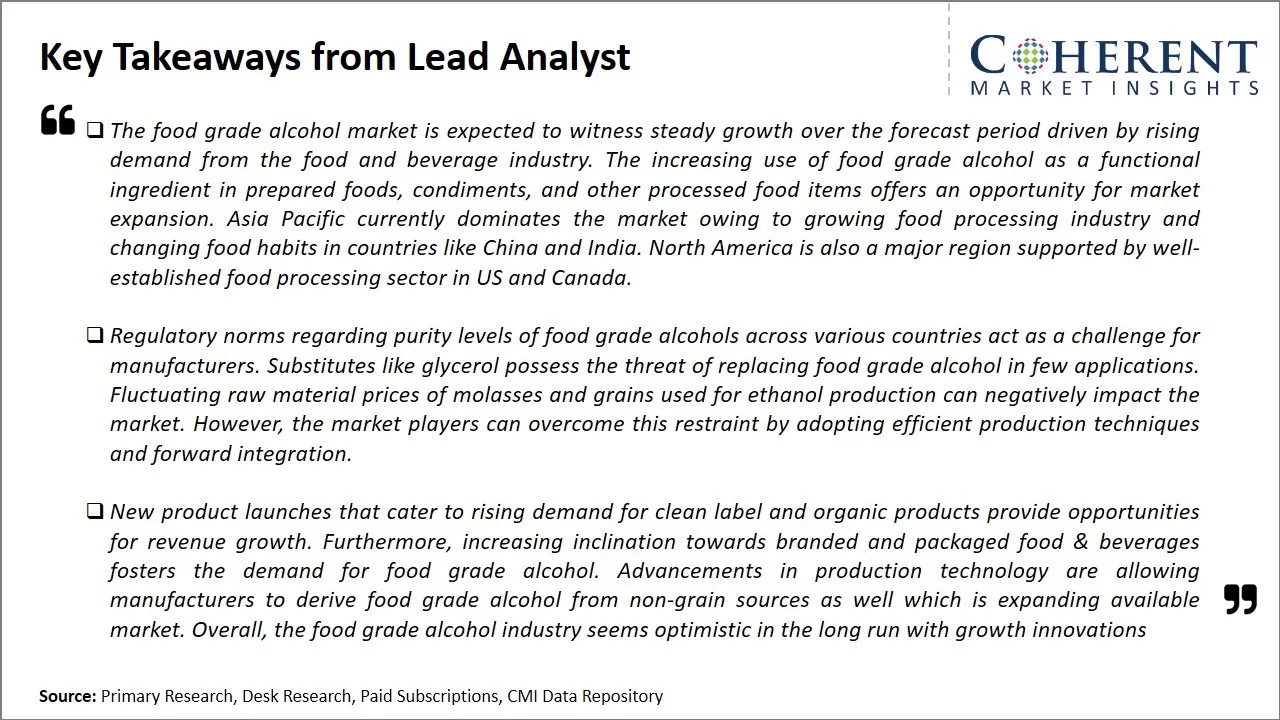
To learn more about this report, Download Free Sample
Market Challenges: Stricter regulations around alcohol concentrationsThe food grade alcohol market faces several challenges. Stricter regulations around alcohol concentrations are restricting product launches. Additionally, health consciousness is shifting the consumer preference towards low-alcohol or alcohol-free beverages. The production of food grade alcohol requires adherence to quality and purity guidelines set by regulatory bodies which increases operational costs. Fluctuating agricultural commodity prices also impact production costs. Supply chain disruptions due to COVID-19 have temporarily disrupted market dynamics though demand has remained steady overall.
Market Opportunities: Increasing prevalence of on-the-go lifestyles and demand for functional drinks
The market sees several opportunities for growth. Increasing prevalence of on-the-go lifestyles and demand for functional drinks have pushed the development of products containing food grade alcohol as an ingredient. Emerging markets across Asia Pacific and Latin America present a lucrative consumer base.
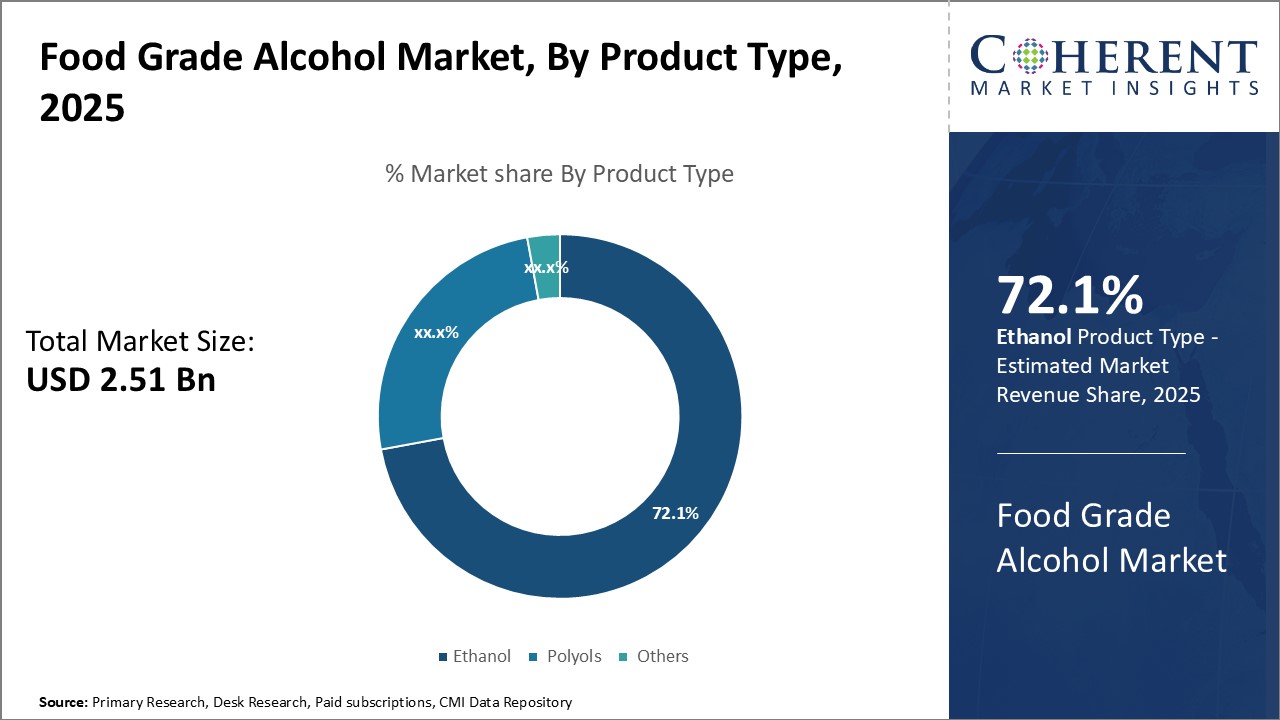
Discover high revenue pocket segments and roadmap to it: Download Free Sample
Insights, By Product Type: Cost Effectiveness Drives the Dominance of EthanolIn terms of product type, ethanol contributes the 72.1% share of the market owing to its cost effectiveness compared to other product types. As the basic component of alcoholic beverages, ethanol is relatively inexpensive to produce at scale from various feedstock. The large volumes demanded by the food and beverage industry allow ethanol producers to benefit from economies of scale in their manufacturing operations. Strategic partnerships between alcohol producers and agricultural companies ensure a steady, low-cost supply of raw materials like grains and molasses that keep production costs down. Ethanol is also highly versatile as an ingredient. It serves as the main constituent in popular alcoholic drinks like beer, wine and spirits. Because it is miscible in water, ethanol blends well into diverse food and beverage formulations. This versatility means that ethanol demand spans wide-ranging application areas from adult beverages to culinary uses. Producers face little incentive to invest in developing alternative product types when ethanol fulfills needs so cost-effectively. New extraction and fermentation techniques continue optimizing ethanol manufacturing processes. Advanced operations leverage digital technologies and automation to minimize inputs and wastage per unit of output. As production efficiency rises, overall ethanol costs decline further. Low prices solidify ethanol's popularity relative to substitutes. Even as alternative alcohols emerge, none has demonstrated clear cost advantages that could seriously threaten ethanol's market dominance driven by its cost effectiveness.
Insights, by Source: Abundant Raw Material Resources Sustain Sugarcane Supremacy
In terms of source, molasses and sugarcane contribute 39.4% of the market share due to the abundant raw material resources available in major producing regions. Tropical climates provide ideal growing conditions for sugarcane, allowing year-round cultivation in top cultivating countries. Their favorable weather means two or more harvests annually, maximizing yields. Meanwhile, molasses is a ubiquitous byproduct of sugar refining operations co-located near cane-growing zones. Together these factors concentrate sugarcane and molasses production among a handful of global giants. Just five countries account for over half of sugarcane output worldwide. Their commanding scale of cultivation supports cost-competitive internal supply chains for converting molasses into fuel grade and industrial alcohol. Self-contained sourcing also enhances supply chain resilience amidst demand fluctuations or external disruptions. With sugarcane-growing resources that outstrip domestic needs, export-oriented refining sectors evolved in major producers. Their surplus molasses finds new commercial applications as distillery feedstock. Continued agricultural innovation tailored for tropical climates further boosts cane yields and molasses recoveries. As reserves accumulate, sugarcane and especially molasses will remain plentiful, affordable resources to support alcohol production growth far into the future. Alternative feedstock struggle to compete given limitations in raw material endowments.
Insights, by Application: Food and Beverage Applications Stimulate Demand
In terms of application, food and beverages contribute 41.7% share of the market due to rising alcohol consumption worldwide. Ethanol sees expanding use not just as the principal component of drinks but also as a culinary ingredient and preservative. Its bactericidal properties harness naturally through evaporation or manufacture into solutions. Cultural trends toward more relaxed social drinking and experimentation with premium craft spirits stimulate liquid alcohol demand. Evolving health awareness boosts interest in ethanol’s anti-bacterial attributes in foods as a “cleaner” preservative than artificial chemicals. As global populations and middle classes grow, food and beverage manufacturers ramp up output using ethanol to meet burgeoning demand. Adoption in emerging markets particularly accelerates the applications segment. Rising incomes expose more consumers to Western-style alcohol usage and priorities around natural, minimally-processed ingredients. Food grade ethanol capitalizes on these nutrition-based values during Asia and Latin America’s continued economic ascent. Its competitive pricing relative to alternatives ensures broad accessibility. Advancements innovating new ethanol formulation and delivery methods further spotlight culinary benefits. Such applications will support the expansion of food and beverage is expected to drive the segment growth. For instance, according to data published by Invest India in 2023, by 2025 the Indian food processing market is estimated to reach US$ 535 Bn, growing at a compound annual growth rate of 15.2%.
Regional Insights
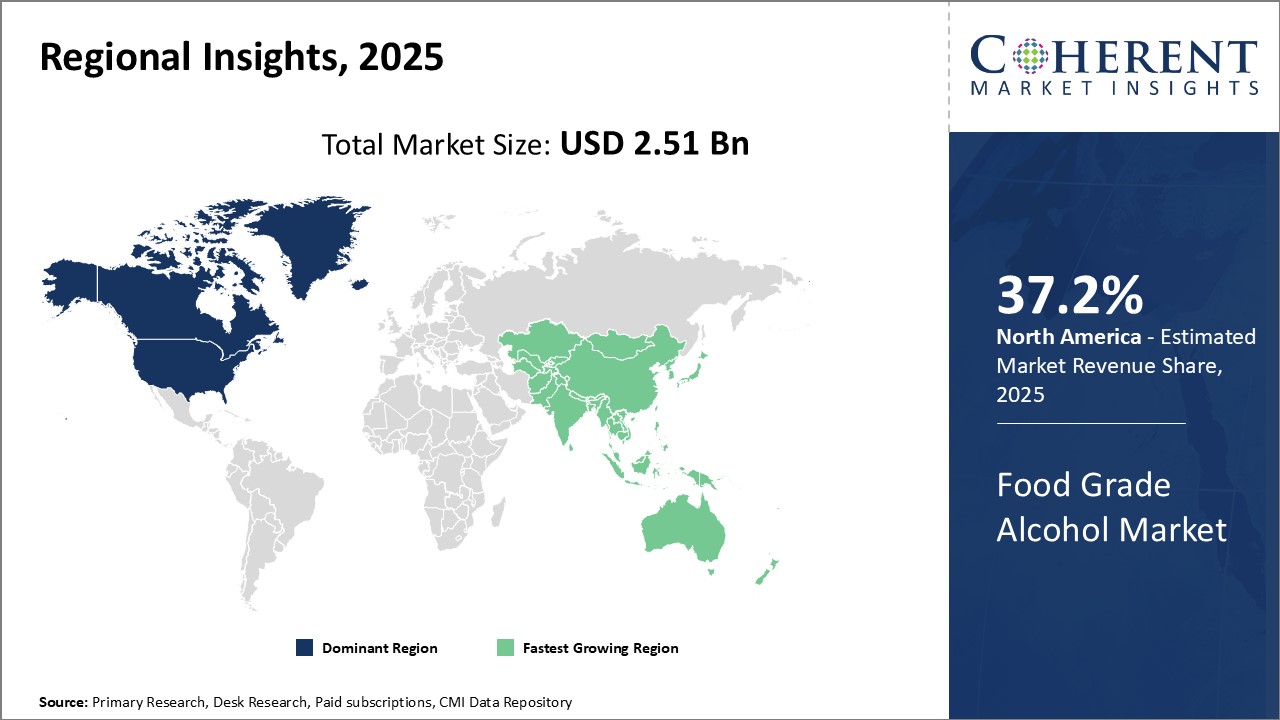
Need a Different Region or Segment? Download Free Sample
North America has established itself as the dominant region in the global food grade alcohol market with 37.2% of the market share. With the presence of key manufacturers and a burgeoning craft beverage industry, North America accounts for the largest share. The U.S. is a major exporter of food grade alcohol and is home to some of the largest spirits and beer companies. The demand for food grade alcohol from these companies has propelled the regional market. Stringent regulations and quality standards in the region have ensured the supply of high quality alcohol meets the requirements of end-use industries. This has attracted several foreign players to set up production facilities in the region to cater to the local demand. The established distribution channels and logistics infrastructure has facilitated the seamless supply of alcohol across the U.S. and Canada.
Asia Pacific has emerged as the fastest growing regional market for food grade alcohol. The growing middle class, rising disposable incomes, and changing lifestyles have bolstered the demand for alcoholic beverages in countries like China, India, and Japan. Local manufacturers are partnering with international players to gain access to new technologies and expertise to produce high-end alcoholic products. Countries like India has seen exponential growth in the craft beer segment. The government's support through easing of regulations has given a fillip to this industry. This has spurred the need for robust supply of food grade alcohol. Moreover, these developing nations are also looking to establish themselves as key export hubs. This has prompted investments to expand production capacities and meet the growing global demand. Another key factor influencing the Asia Pacific market is the increasing adoption of alcohol as an ingredient across various end-use industries apart from beverages. Food grade alcohol finds wide applications in personal care products, pharmaceuticals and others. The large consumer base provides immense opportunities to cater to this diversifying demand. This makes Asia Pacific an important region to watch out for in the coming years as income levels rise and lifestyles evolve rapidly across the region.
Market Report Scope
Food Grade Alcohol Market Report Coverage
| Report Coverage | Details | ||
|---|---|---|---|
| Base Year: | 2024 | Market Size in 2025: | USD 2.51 Bn |
| Historical Data for: | 2020 To 2024 | Forecast Period: | 2025 To 2032 |
| Forecast Period 2025 to 2032 CAGR: | 4.4% | 2032 Value Projection: | USD 3.39 Bn |
| Geographies covered: |
|
||
| Segments covered: | |||
| Companies covered: |
MGP, Cargill Incorporated, ADM, Cristalco, Grain Processing Corporation, Wilmar International Ltd., Extractohol, Pure Alcohol Solutions, Nedstar, Sasma B.V., Roquette Frères , Essentica, AVANSCHEM, Fairly Traded Organics, and Ethimex Ltd |
||
| Growth Drivers: |
|
||
| Restraints & Challenges: |
|
||
Uncover macros and micros vetted on 75+ parameters: Get instant access to report
Food Grade Alcohol Industry News
- In November 2022, ASSIST and Cargill joined forces to enhance food security in the Philippines by focusing on improving the skills of smallholder maize growers. This collaboration aimed to uplift the agricultural practices and capabilities of these farmers, ultimately contributing to a more sustainable and resilient food system in the region.
- On August 18, 2022, ADM and New Culture announced a strategic partnership to expand the market for alternative dairy products. The partnership focuses on product development and commercialization, and takes advantage of New Culture's innovations in novel ingredients and animal-free dairy products.
*Definition: The food grade alcohol market consists of the manufacturing, distribution, and sales of alcohol that is considered safe for human consumption and approved by regulatory bodies for use in food and beverages. Some examples include ethanol, isopropyl alcohol, and denatured alcohol that meet stringent purity standards set by the FDA. These alcohols are widely used as processing aids and preservatives in foods, beverages, condiments, extracts, and other edible products.
Market Segmentation
- Product Type Insights (Revenue, USD Bn & KT, 2020 - 2032)
- Ethanol
- Polyols
- Others
- Source Insights (Revenue, USD Bn & KT, 2020 - 2032)
- Molasses & Sugarcane
- Fruits
- Others (Grains, etc.)
- Application Insights (Revenue, USD Bn & KT, 2020 - 2032)
- Healthcare & Pharmaceutical
- Food & Beverages
- Personal Care
- Others
- Regional Insights (Revenue, USD Bn & KT, 2020 - 2032)
- North America
- U.S.
- Canada
- Latin America
- Brazil
- Argentina
- Mexico
- Rest of Latin America
- Europe
- Germany
- U.K.
- Spain
- France
- Italy
- Russia
- Rest of Europe
- Asia Pacific
- China
- India
- Japan
- Australia
- South Korea
- ASEAN
- Rest of Asia Pacific
- Middle East & Africa
- GCC Countries
- Israel
- Rest of Middle East & Africa
- North America
- Key Players Insights
- MGP
- Cargill Incorporated
- ADM
- Cristalco
- Grain Processing Corporation
- Wilmar International Ltd.
- Extractohol
- Pure Alcohol Solutions
- Nedstar
- Sasma B.V.
- Roquette Frères
- Essentica
- AVANSCHEM
- Fairly Traded Organics
- Ethimex Ltd
Share
Share
About Author
Vidyesh Swar is a seasoned Consultant with a diverse background in market research and business consulting. With over 6 years of experience, Vidyesh has established a strong reputation for his proficiency in market estimations, supplier landscape analysis, and market share assessments for tailored research solution. Using his deep industry knowledge and analytical skills, he provides valuable insights and strategic recommendations, enabling clients to make informed decisions and navigate complex business landscapes.
Missing comfort of reading report in your local language? Find your preferred language :
Transform your Strategy with Exclusive Trending Reports :
Frequently Asked Questions
EXISTING CLIENTELE
Joining thousands of companies around the world committed to making the Excellent Business Solutions.
View All Our Clients
